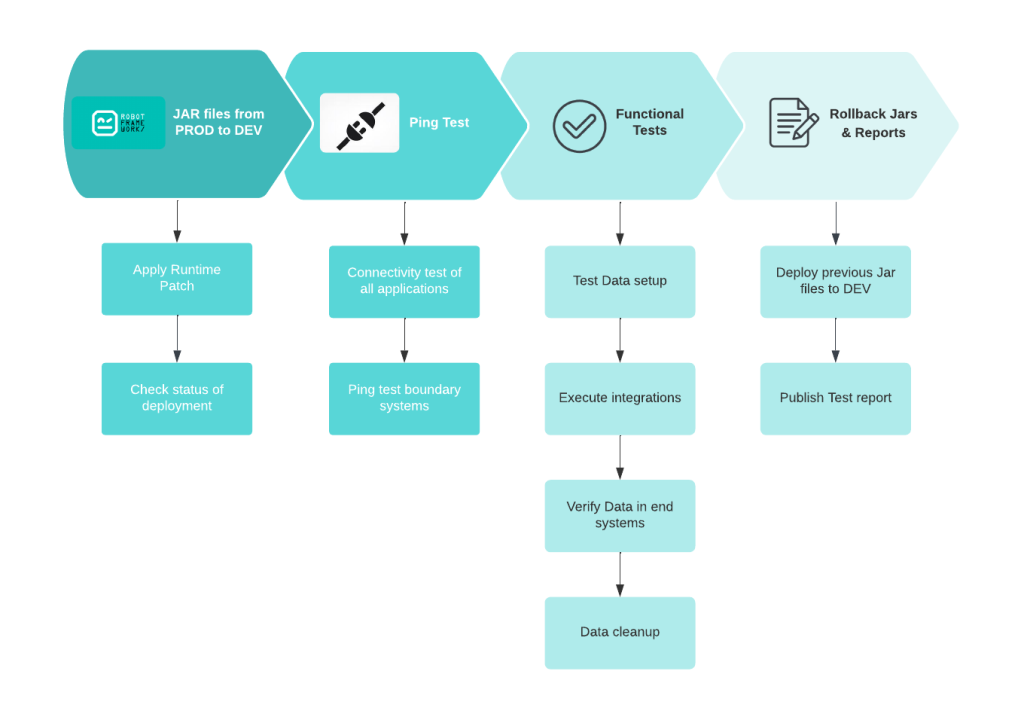In software development, ensuring application integration and functionality is essential. For MuleSoft, the challenge is even more pronounced due to the growing number of applications, parallel projects, lack of test data, monthly runtime patches, and stringent security and compliance requirements. These factors often lead to operational disruptions. To mitigate these challenges, test automation frameworks play a crucial role.
Application ecosystems continue to expand along the traditional lines of digital transformation and to incorporate a variety of AI tools. Layer on everything mentioned above, and the challenges associated with this continued growth can become a real burden.
Faced with these circumstances, minimizing operational disruptions is paramount, so one of the best ways to ensure seamless service delivery is through an automated testing framework.
What is a test automation framework?
An automated UI test framework is a structured set of guidelines, tools, and libraries designed to create and execute UI tests for web or desktop applications.
The key components of these frameworks usually include:
- Test scripts: These are the actual test cases automated using the framework, written in a programming language supported by the framework.
- Test runner: This core component executes the automated tests, controls the flow, reports the results, and generates logs.
- Test reporting: The framework generates detailed reports summarizing the tests executed, results, and any errors or issues encountered.
Test automation frameworks
Several frameworks are available for test automation, each with their respective strengths:
- Karate framework: Primarily used for testing web-based microservices, APIs, and backends, Karate provides a simple, English-like syntax to write test cases and supports JSON and XML-based requests and responses. It also offers built-in support for browser automation using the Selenium WebDriver API.
- Nui framework: Focuses on the behavior of the application and can be used by Business Systems Analysts (BSAs), Product Owners (POs), and other teams. It is applicable for testing both UI and API-based functionality, with test cases derived from and closely representing Acceptance Criteria. The framework is implemented with reusable, easily maintainable functions.
- CSG framework: Aims to unify and standardize the test automation framework across CSG, giving scrum teams the flexibility to build functional/application test suites and utilities in their individual test automation folders.
- Robot framework: An open-source automation framework for test automation and robotic process automation (RPA). Supported by the Robot Framework Foundation, it is widely used in the industry due to its human-friendly and versatile syntax, which uses keywords and supports extensions through libraries in Python, Java, and other languages. It integrates with other tools for comprehensive automation without licensing fees and is bolstered by a rich community with hundreds of third-party libraries.
Why choose the robot test automation framework?
While there are mocking frameworks available, it won’t solve all the scenarios every time. From an integration perspective, having actual test data is critical for end to end testing. Most of the integration teams are dependent on various upstream boundary systems for the test data creation part. This often involves a lot of coordination between various cross functional teams. Having a lot of human interactions would hamper our ability to test patches for all the applications on time. Robot frameworks’ ability to create test data in various UI systems and databases also play a major role.
In the context of MuleSoft, the robot test automation framework stands out for several reasons:
- Test data creation: It can create test data in boundary systems and other UI-based apps. Many frameworks lack this ability. Having one framework for creating test data as well as end to end test automation is one of the major differentiators.
- Skillset availability: Engineering managers face challenges in identifying people with the right skillset to add into their projects. In agile development, automation testing plays a crucial role. Using a tool that is widely used improves time-to-market, easing automation script maintenance.
- Human-friendly syntax: Its keyword-driven approach makes it easy to write and understand test cases.
- Extensibility: It can be extended by defining custom keywords, functions, and variables or expanded using the Python programming language.
- Built-in Salesforce library support: It includes predefined Salesforce-specific keywords helpful in navigating Salesforce pages, clicking specific elements, and filling out forms.
- CI/CD integration: Test cases can be integrated with CI/CD pipelines, providing the ability to continuously test.
Steps for MuleSoft monthly patch automation via robot framework
A standout use case for deploying such a framework would be to automate the monthly patching process to significantly reduce operational disruptions. MuleSoft releases patches every month and it is very essential to have the latest patches to be applied to avoid any security issues or compliance issues.
While staying compliant, it’s essential to test all the MuleSoft applications to ensure that the patch is working properly and not impacting the functionality or behavior of the application. In this context, it is essential to perform regression testing on a monthly basis.
Testing applications manually is a cumbersome task and chances of testing all the major workflows end-to-end is not realistic. While applications grow in number, automation is the right choice.
Steps for testing monthly patches for Anypoint applications:
- Download from UAT/Stage environment and upload jars in lower environments
- Check application status (start/stop)
- Apply MuleSoft patches by updating the Runtime version
- Execute Ping Tests for connectivity with the boundary systems
- Execute Robot functional tests from Jenkins pipeline
- Create Test data in Boundary systems
- Perform validations using the scripts
- Once the report is generated, clean up the test data
- Publish the test results
Repeat the above steps for all the applications by Configuring it in a Jenkins job with a list of applications and also for multiple CloudHub business groups.

Leveraging the Robot Framework for MuleSoft integration test automation can offer a robust, extensible, and community-supported solution.It addresses the challenges of growing applications, parallel projects, and monthly runtime patches, ensuring smooth operations and compliance.
Through integrating with CI/CD pipelines and creating test data in boundary systems, an automated testing framework enhances the efficiency and reliability of the testing process, making it an invaluable tool when applying patches.









